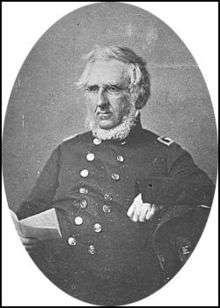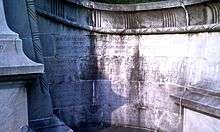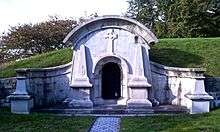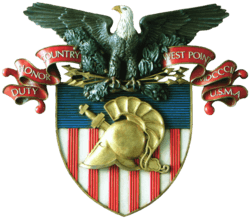Richard Delafield
| Richard Delafield | |
|---|---|
 Richard Delafield | |
| Personal details | |
| Born |
September 1, 1798 New York City, New York |
| Died |
November 5, 1873 (aged 75) Washington, D.C |
| Resting place | Green-Wood Cemetery Brooklyn, New York |
| Spouse(s) | Harriet Baldwin |
| Relations | Edward Delafield (brother) |
| Children | 6 |
| Military service | |
| Allegiance |
United States of America Union |
| Service/branch |
United States Army Union Army |
| Years of service | 1818–1866 |
| Rank |
|
| Commands | United States Army Corps of Engineers |
| Battles/wars | American Civil War |
Richard Delafield (September 1, 1798 – November 5, 1873) served as superintendent of the United States Military Academy, was Chief of Engineers, and was a major general in the Union Army during the American Civil War.



Early life
Delafield, born in New York City, New York, one of the 14 children of John and Anne (née Hallett) Delafield. His father had emigrated to New York from England in 1788 and made a fortune as a merchant. His brother was Edward Delafield (1794–1875), a prominent American physician.
He was the first graduate of the United States Military Academy to receive a merit class standing, ranking first in the class of 1818. Commissioned in the Corps of Engineers, he was a topographical engineer with the American commission to establish the northern boundary under the Treaty of Ghent.
Military career
He served as assistant engineer in the construction of Hampton Roads defenses from 1819–1824 and was in charge of fortifications and surveys in the Mississippi River delta area from 1824-1832. While superintendent of repair work on the Cumberland Road east of the Ohio River, he designed and built Dunlap's Creek Bridge in Brownsville, Pennsylvania, the first cast-iron tubular-arch bridge in the United States. Appointed superintendent of the Military Academy after the fire in 1838, he designed the new buildings and the new cadet uniform that first displayed the castle insignia. He superintended the construction of coast defenses for New York Harbor from 1846-1855.
In 1855, Delafield formed the Delafield Commission, and was sent by the Secretary of War, Jefferson Davis, to Europe, including the Crimea, to observe the European military. The commission also included officers George B. McClellan and Alfred Mordecai. They served as military observers at the Siege of Sevastopol during the Crimean War.
Delafield served as superintendent of the Military Academy again from 1856-1861. He was in charge of New York Harbor defenses (1861–64) and Chief Engineer from 1864 until his retirement in 1866.
Personal life
He married Harriet Baldwin (1811–1894), with whom he had:
- Henry Baldwin Delafield (1834–1847)
- Susan Parish Delafield (1836–1896)
- Juliet Covington Delafield (1837–1925)
- Emma Delafield (1840–1938)
- Laura Delafield (1843–1886)
- Albert Delafield (1846–1920), who married Julia Floyd (1846–1929), granddaughter of U.S. Representative William Floyd[1]
Delafield died in Washington, D.C. The Secretary of War ordered that 13 guns be fired in his memory at West Point. He is buried at Green-Wood Cemetery in Brooklyn, New York.
See also
References
- ↑ Ross, Peter; Pelletreau, William Smith. A History of Long Island: From Its Earliest Settlement to the Present Time. Lewis publishing Company. Retrieved 20 October 2016.
This article contains public domain text from "Brigadier General Richard Delafield". Portraits and Profiles of Chief Engineers. Archived from the original on April 4, 2005. Retrieved May 24, 2005.
External links
- Civil War Defenses of Washington, Historic Resource Study, by the U.S. National Park Service, Part 1, Chapter 5
- Civil War Defenses of Washington, Historic Resource Study, by the U.S. National Park Service, Part 2, Chapter 1
- “ Ridiculous failure” - George McClellan and the Delafield Commission
- America’s Civil War Comes to West Point
- Engineers In The Civil War
- Transportation Of The Wounded In The Civil War
| Military offices | ||
|---|---|---|
| Preceded by René Edward De Russy |
Superintendent of the U.S. Military Academy 1838–1845 |
Succeeded by Henry Brewerton |
| Preceded by John Gross Barnard |
Superintendent of the U.S. Military Academy 1856–1861 |
Succeeded by P.G.T. Beauregard |
| Preceded by P.G.T. Beauregard |
Superintendent of the U.S. Military Academy 1861–1861 |
Succeeded by Alexander Hamilton Bowman |
| Preceded by Joseph Gilbert Totten |
Chief of Engineers 1864–1866 |
Succeeded by Andrew A. Humphreys |
